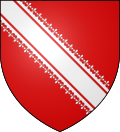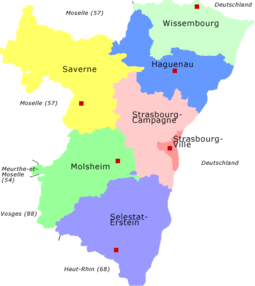Bas-Rhin department
| Bas-Rhin | |
|---|---|
| region | Grand Est |
| prefecture | Strasbourg |
| Sub-prefecture (s) |
Haguenau Molsheim Saverne Sélestat Strasbourg |
| Residents | 1,125,559 (Jan. 1, 2017) |
| Population density | 237 inhabitants per km² |
| surface | 4,756.86 km² |
| Arrondissements | 5 |
| Community associations | 25th |
| Cantons | 23 |
| Communities | 514 |
|
President of the Department Council |
Frédéric Bierry ( UMP ) |
| ISO-3166-2 code | FR-67 |
 Location of the Bas-Rhin department in the region of Grand Est |
|
The department Bas-Rhin [ bɑˈʀɛ̃ ] (literally Lower Rhine ) is the French department with the serial number 67. It is located in the north-east of the country in the Grand Est region . Together with the Haut-Rhin department , it forms the Alsace . The names of both departments come from the course of the Rhine in France, which forms its state border with Germany . In German usage, Bas-Rhin is also known as Lower Alsace .
According to a survey in 2013, 46% of the residents still spoke an Alemannic or Franconian dialect, more than in the neighboring departments of Haut-Rhin and Moselle .
The departments of Bas-Rhin and Haut-Rhin are (as of March 18, 2020) the departments in France most affected by the COVID-19 pandemic .
geography
The department borders on the state of Rhineland-Palatinate to the north, the state of Baden-Württemberg in the east, the Haut-Rhin department in the south, the Vosges and Meurthe-et-Moselle departments in the south-west and the Moselle department in the west .
The department is located in the north of Alsace . The eastern border of the department is formed by the Rhine , in the west the northern foothills of the Vosges run through the department. In the north it borders on the Palatinate Forest and the Lauter .
history
Foundation and older history
The department was formed during the French Revolution on March 4, 1790 from the northern part of the then existing province of Alsace . It was divided into the four districts (French districts ) Haguenau, Benfeld, Strasbourg and Wissembourg, the forerunners of the arrondissements . The department and the districts were divided into 32 cantons and had about 400,000 inhabitants. Strasbourg was already the capital at that time .
After the annexation of the county of Saar Werden by France in 1794 (today Alsace bossue / Krummes Alsace ), Sarre-Union was founded as the fifth district. The district of Schlettstadt emerged from the Benfeld district.
The arrondissements (German municipal districts ) Barr (instead of Schlettstadt), Saverne (instead of Sarre-Union), Strasbourg and Wissembourg were established on February 17, 1800. On February 10, 1806 Barr was again replaced by Schlettstadt.
In 1809 63 or 66 families, most of whom came from the southern Palatinate , which was devastated by the Napoleonic Wars , accepted the invitation of Tsar Alexander I and emigrated to Russia, where they founded the mother colony in Landau . Most of the Alsatian families came from the canton of Weißenburg , the Palatinate from the districts of Germersheim , Bergzabern , Landau and Pirmasens .
Through the Congress of Vienna in 1815, the department lost a northern part that today belongs to the southern Palatinate, including the city of Landau in the Palatinate .
District of Lower Alsace in the German Empire
From May 10, 1871 ( Peace of Frankfurt ) to June 28, 1919 ( Peace Treaty of Versailles ), the department was part of the German Empire . As the district of Lower Alsace , it belonged to the realm of Alsace-Lorraine . The district was divided into the eight districts of Erstein, Hagenau , Molsheim , Schlettstadt, Strasbourg (city) , Strasbourg (country) , Weißenburg (as before) and Zabern (as before). The district covered 4,778 km² and in 1885 had 612,077 inhabitants.
A district president was at the head of the district. District presidents were:
| president | Term of office |
|---|---|
| Friedrich of Luxburg | 1870–1871 ( acting ) |
| Adolf Ernst von Ernsthausen | 1871-1875 |
| Carl Ledderhose | 1875-1880 |
| Otto Back | 1880-1886 |
| Joseph Philipp von Stichaner | 1886-1889 |
| Julius von Freyberg-Eisenberg | 1889-1898 |
| Alexander Halm | 1898-1907 |
| Otto Pöhlmann | 1907-1918 |
The parliament in the district was the district day . This elected 10 members (from 1879: 13) to the regional committee of the Reichsland Alsace-Lorraine until 1911 with the constitution of the state parliament.
Since the end of the First World War
After the German Reich lost World War I , the Lower Alsace district became French again. The subdivision into districts (= arrondissements) was completely adopted by the French Republic. The district of Zabern became the arrondissement of Saverne, Strasbourg (city) to Strasbourg-Ville, Strasbourg (country) to Strasbourg-Campagne and Schlettstadt to Sélestat.
Structure 1974 to 2014
On May 24, 1974, the arrondissements of Erstein and Sélestat were merged to Sélestat-Erstein with the administrative seat of Sélestat . From then until December 31, 2014, the Bas-Rhin department was divided into 7 arrondissements , 44 cantons and 527 communes .
On January 1, 2015, the Haguenau and Wissembourg arrondissements were merged into Haguenau-Wissembourg with the Haguenau administrative center . Strasbourg-Ville and Strasbourg-Campagne were combined to form the Strasbourg arrondissement . The arrondissements were redesigned, only Sélestat-Erstein remained unchanged.
| Arrondissement (1974-2014) |
Population (2017) |
Area (km²) |
Population density ( population / km²) |
Cantons | Communities |
|---|---|---|---|---|---|
| Haguenau | 241,346 | 666 | 362.4 | 3 | 56 |
| Molsheim | 103,783 | 745 | 139.3 | 5 | 69 |
| Saverne | 129.105 | 1.003 | 128.7 | 6th | 128 |
| Sélestat-Erstein | 157.236 | 981 | 160.3 | 7th | 101 |
| Strasbourg Campagne | 684 | 8th | 104 | ||
| Strasbourg-Ville | 494.089 | 78 | 6,334.5 | 10 | 1 |
| Wissembourg | 598 | 5 | 68 |
1960–2015 Alsace formed its own region, since then the department has belonged to the Grand Est region .
Cities
The most populous municipalities in the department are:
| city | Population (2017) |
Arrondissement |
|---|---|---|
| Strasbourg (Strasbourg) | 280.966 | Strasbourg |
| Haguenau (Hagenau) | 34,504 | Haguenau-Wissembourg |
| Schiltigheim | 31,894 | Strasbourg |
| Illkirch-Graffenstaden (Illkirch-Grafenstaden) | 26,780 | |
| Sélestat (Schlettstadt) | 19,252 | Sélestat-Erstein |
| Lingolsheim | 18,324 | Strasbourg |
| Bischheim | 17.093 | |
| Ostwald | 12,604 | |
| Bischwiller (Bischweiler) | 12,538 | Haguenau-Wissembourg |
| Hœnheim (Hönheim) | 11,215 | Strasbourg |
Administrative division
The Bas-Rhin department is divided into 5 arrondissements , 23 cantons and 514 communes :
| Arrondissement | Cantons | Communities | Residents January 1, 2017 |
Area km² |
Density of population / km² |
Code INSEE |
|---|---|---|---|---|---|---|
| Haguenau-Wissembourg | 5 | 141 | 241,346 | 1,424.63 | 169 | 672 |
| Molsheim | 3 | 77 | 103,783 | 771.20 | 135 | 673 |
| Saverne | 3 | 162 | 129.105 | 1,241.00 | 104 | 674 |
| Sélestat-Erstein | 5 | 101 | 157.236 | 980.57 | 160 | 675 |
| Strasbourg | 11 | 33 | 494.089 | 339.46 | 1,456 | 678 |
| Bas-Rhin department | 23 | 514 | 1,125,559 | 4,756.86 | 237 | 67 |
See also:
- List of communes in the Bas-Rhin department
- List of cantons in the Bas-Rhin department
- List of associations of municipalities in the Bas-Rhin department
Personalities
Senators of the Bas-Rhin department
Senators of the Bas-Rhin department were or are:
coat of arms
Blazon : In red a white diagonal bar with a lily meander on both sides.
Web links
- Département Bas-Rhin (French, German partly, English partly)
- Prefecture of the Bas-Rhin department (French)
- Literature on the Bas-Rhin department in the catalog of the German National Library
- Tourism in the Bas-Rhin department (French-German-English)
- Historical map (as a digitized edition of the University and State Library Düsseldorf )
Footnotes
- ↑ http://www.bas-rhin.fr/le-conseil-departemental/le-cd67/frederic-bierry-president-conseil-departemental-bas-rhin ( page no longer available , search in web archives ) Info: The link was automatically marked as defective. Please check the link according to the instructions and then remove this notice. accessed on May 1, 2015.
- ^ Etude sur le dialecte alsacien. Accessed February 4, 2014
- ↑ Comité consultatif pour la promotion des langues régionales et de la pluralité linguistique intern : Redéfinir une politique publique en faveur des langues régionales et de la pluralité linguistique intern . July 2013, p. 94 (French, Rapport Langues de France - comité consultatif [accessed on April 16, 2017]).
- ↑ FAZ.net March 18, 2020: There are no more Covid 19 beds
- ^ A b Karl Stumpp: The emigration from Germany to Russia in the years 1763–1862 . Ed .: Country team of Germans from Russia. 9th edition. 2009, p. 90 .
- ↑ Beresan District Odessa Newsletter. (PDF; 471 kB) (No longer available online.) June 1996, p. 4 f. , archived from the original on November 13, 2013 ; accessed on December 30, 2013 (English, edition 1.1). Info: The archive link was inserted automatically and has not yet been checked. Please check the original and archive link according to the instructions and then remove this notice.
- ^ Alfred Eisfeld: 200 years of settlement of the Germans in the Black Sea area. (PDF; 2.0 MB) Landsmannschaft der Deutschen aus Russia, pp. 5, 17 , accessed on December 30, 2013 .
- ^ The settlement manifesto of Alexander I. (No longer available online.) Migrationsmuseum.it, February 20, 1804, archived from the original on December 27, 2013 ; accessed on December 30, 2013 . Info: The archive link was inserted automatically and has not yet been checked. Please check the original and archive link according to the instructions and then remove this notice.
- ↑ Administrative history
- ^ Except for Sélestat-Erstein , all arrondissements have been redesigned.
Coordinates: 48 ° 35 ' N , 7 ° 42' E





